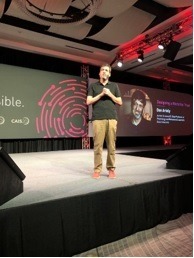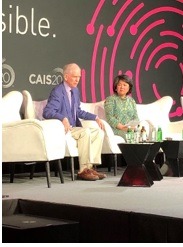John Bowman, CFA, Senior Managing Director at CAIA Association “You’re a kite dancing in a hurricane, Mr. Bond.” (Mr. White to 007, Spectre) Despite the crystal blue island water, softly rolling Caribbean tide, and perfect skies outside the hotel all week, I opened my conference wrap-up panel reminding delegates for the 7th annual 2020 Cayman Alternative Investment Summit that our profession is in a perfect storm of disruptive shifts:
- Geopolitical dysfunction: Ian Bremmer argued we have entered a geopolitical recession. If the coronavirus is not a pandemic, clearly the lack of civic leadership around the world is.
- Capital Formation: Tectonic shifts from public to private capital are structurally altering the sources and networks of funding growth. This has significant implications for the role of public exchanges, strategic asset allocation and regulations around retail access to certain asset classes.
- Pension Crisis: The endemic funding state of the global public pension system is not new but being exacerbated by secularly low interest rates. Desperate and voracious hunts for alpha have ensued, often for the wrong motivations.
- Digital Arms Race:Asset Management cultures, talent wars, and operations are being turned upside down by the onslaught of artificial intelligence and data science.
- Inclusive and Purposeful Capitalism: Alignment amongst beneficiaries, LPs and GPs has never been higher to address climate risk…but the real agent of change, sovereign governments, remain largely passive in the discussion.
This confluence of events is pressuring the industry on all sides, forcing us into more existential questions about our value, relevance and influence on the financial eco-system and broader society. And yet, I left more confident that CAIA Association has an increasingly more public and bolder role to play as the professional body for the alternative investment industry. As a major sponsor for the premier global event on alternative investing, we moderated three panels outlining the future of the industry and facilitated a closed door event amongst 15 allocators to explore how we might collectively tackle the strategic challenges facing the world’s largest asset owners. The content was thought provoking, timely, and compelling and I wanted to share a few of those themes with you. 
- It’s a right-brained world and I'm a right-brained boy
I grew up in the Cold War and cut my professional teeth shortly after the Berlin Wall came down. What followed was a fairly benign two decades of geopolitical chess…Pax Americana of sorts. Fundamentals mattered. Earnings growth, relative valuation, product traction were the ingredients to determine the winners and losers in our portfolios. Times have changed. Non-financial measures like carbon footprint, trade disputes over Twitter, and populism have clouded the investment research process. Allocators and Asset managers may claim they continue to “look through the noise,” but the reality is the noise is a whole lot louder and more palatable these days. I’m sure some of this is the ubiquity of social media and news feeds but look no further than Ian Bremmer keynoting every major investment conference as proof that we’ve come a long way since a few of us purchased the idiosyncratic political research of ISI. What is the goodwill discount for a company with growing risk of stranded oil well assets, coastline real estate, or farmland when climate change poses a threat to their value, or even existence? And is that discount rate a function of public sentiment, legislative momentum, technological alternatives, or worldviews of those temporarily in office? How will a decoupling of the world’s technological supply chains amongst the two global super-powers effect the digital landscape? How do we assess future cash flows of these players when national security interests, not technical efficacy, drive adoption? And ultimately, what does this all mean for training tomorrow’s investment professionals? Apple’s famous “There’s an app for that,” rings fairly hollow as the traditional MBA and professional designation curricula aren’t equipped to provide the toolset to prepare us for today’s hyper-dynamic and emotional world. Interdisciplinary studies, communication skills, emotional intelligence, intellectual curiosity, and leadership must be more explicitly embedded into curricula, recruiting, and on the job training. 
- Those aren’t the benchmarks you’re looking for
I’m embarrassed to say that the first time I understood leadership development was after I stopped running portfolios. Healthy culture and investing in future talent were just not in our vernacular when the only report card that ever mattered was starting back at us real-time from the Bloomberg screen. But experience and data over the last two decades have taught me these softer elements are not only an important contributor but perhaps the most significant indicator of sustainable achievement of business outcomes. Culture is the oxygen, the real secret sauce, the ever present “edge” of long term investment performance. Duke University behavioral scientist Dan Ariely spent the day with our allocator roundtable outlining research he’s conducted on 80 factors amongst 800 companies since 2006. Each of these factors captures the annual sentiment of one element of employee engagement and culture such as: Is my work appreciated; Is management transparent; Is there strategic clarity; Are honest mistakes valued etc. Dan has illustrated nearly 500 bps of annual alpha vs. the S&P500 by going long companies that perform well on these factors and shorting the underperforming organizations. I’d encourage you to take a closer look at this research that spawned hedge fund Irrational Capital. What does this mean for LP team cultures and our GP selection process? If our entire manager selection and evaluation apparatus is singularly anchored on past performance, we are fundamentally missing the deep value that human capital investment brings to repeatable results, not to mention nurturing the endemic short-termism of the system. How might we transform the process to capture these important elements? Does the entire value chain need to be disassembled and rebuilt? I wrote about this a few years ago. Further, this idea of misappropriated yardsticks was further evident in the continued discussions of private capital as the panacea for our alpha problem. In other words, the illiquidity premium offers a safe and certain kicker when compared to the late cycle valuations in the public markets. For the record, I think private markets do offer superior returns than public markets over the long term but frankly, that’s often not the point of these asset classes. We’ve lost the ultimate motivations for diversification in our portfolios, uncorrelated return streams, downside protection, inflation hedging, predictable income streams etc. The only benchmark that truly matters is the client’s annual goal and the industry remains paralyzed by comparisons against market weighted public indices that are arbitrary at best, damaging at worst. 
- The original purpose of Finance is alive and well
Perhaps my biggest takeaway however, was virtuous and energizing. In the public markets, increasingly passive and indexed, it’s easy to forget that there are actual companies, products, projects and employees that underly these share purchases. It takes much more cognitive dissonance to look the other way in the private markets as the purpose is much more front and center in the capital transfer. Private capital has much more tangible influence on societal good and investors have much more flexibility in allocating to those endeavors that are aligned with their values and ethic. This original purpose of Finance, that often gets forgotten in today’s world of revenue and carry maximization, was on full display in Cayman last week. Inspiring sessions with IMAGINE, 100 Women in Finance, BecomingX, Reboot the Future Foundation, and the Sustainability Group gave new meaning to the definition of our roles. Perhaps most stirring, however, was the impassioned interview with the unmatchable Jeremy Grantham. One of the founders of GMO in Boston, Grantham and his wife have now devoted their life, and nearly their entire wealth, to fighting climate change through the Grantham Foundation. Channeling some Greta, he did not mince words on the future planetal blight we risk leaving to our grandchildren. The investment profession remains one of the most powerful tools for public good the world has ever seen. These pillars of education, transparency and purpose are hallmarks of the industry and CAIA’s mission. Disruption and challenges aside, I’ve never been more hopeful about the opportunities before us. Watch the full panel conversation. Keep in touch with John Bowman, CFA, Senior Managing Director at CAIA Association on LinkedIn, Twitter, or via email.




